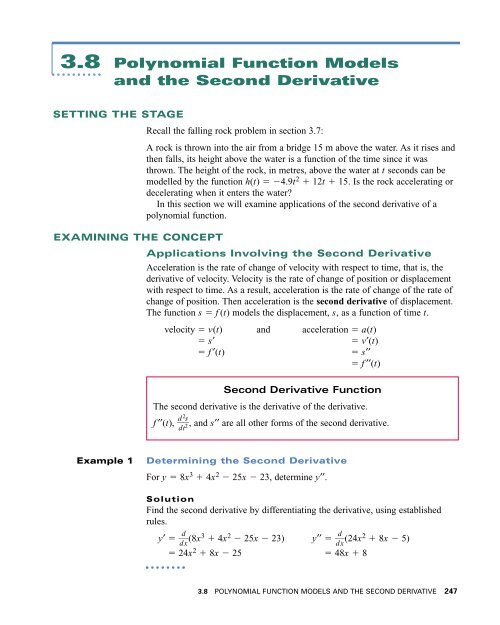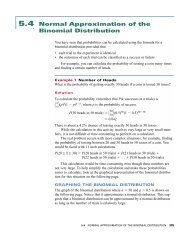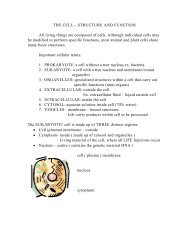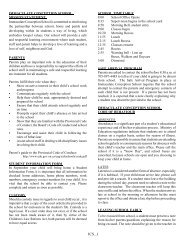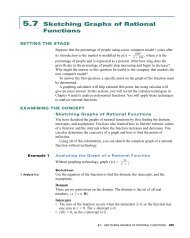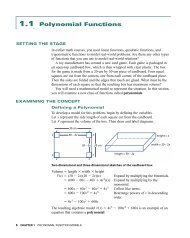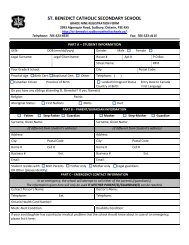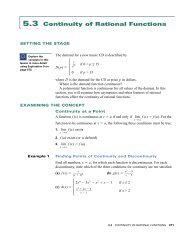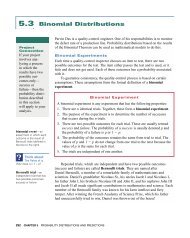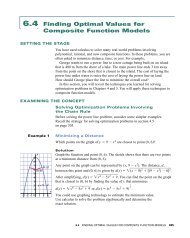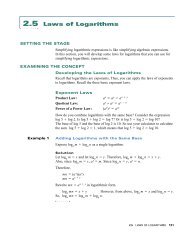Pg 247
Pg 247
Pg 247
You also want an ePaper? Increase the reach of your titles
YUMPU automatically turns print PDFs into web optimized ePapers that Google loves.
3.8 Polynomial Function Models<br />
and the Second Derivative<br />
SETTING THE STAGE<br />
Recall the falling rock problem in section 3.7:<br />
EXAMINING THE CONCEPT<br />
A rock is thrown into the air from a bridge 15 m above the water. As it rises and<br />
then falls, its height above the water is a function of the time since it was<br />
thrown. The height of the rock, in metres, above the water at t seconds can be<br />
modelled by the function h(t) 4.9t 2 12t 15. Is the rock accelerating or<br />
decelerating when it enters the water?<br />
In this section we will examine applications of the second derivative of a<br />
polynomial function.<br />
Applications Involving the Second Derivative<br />
Acceleration is the rate of change of velocity with respect to time, that is, the<br />
derivative of velocity. Velocity is the rate of change of position or displacement<br />
with respect to time. As a result, acceleration is the rate of change of the rate of<br />
change of position. Then acceleration is the second derivative of displacement.<br />
The function s f (t) models the displacement, s, as a function of time t.<br />
velocity v(t) and acceleration a(t)<br />
s′<br />
v′(t)<br />
f ′(t)<br />
s′′<br />
f ′′(t)<br />
Second Derivative Function<br />
The second derivative is the derivative of the derivative.<br />
f ′′(t), d 2<br />
, and s′′ are all other forms of the second derivative.<br />
d<br />
t 2 s<br />
Example 1<br />
Determining the Second Derivative<br />
For y 8x 3 4x 2 25x 23, determine y′′.<br />
Solution<br />
Find the second derivative by differentiating the derivative, using established<br />
rules.<br />
d<br />
y′ d<br />
(8x<br />
x<br />
3 4x 2 d<br />
25x 23) y′′ d<br />
(24x<br />
x<br />
2 8x 5)<br />
24x 2 8x 25 48x 8<br />
3.8 POLYNOMIAL FUNCTION MODELS AND THE SECOND DERIVATIVE <strong>247</strong>
Example 2<br />
Examining the Acceleration of a Falling Object<br />
A rock is thrown into the air from a bridge 15 m above the water. Its height<br />
above the water is a function of the time since it was thrown. The height of the<br />
rock, in metres, above the water can be modelled by the function<br />
h(t) 4.9t 2 12t 15, where h(t) represents the height in metres at<br />
t seconds. What is the rock’s acceleration when it enters the water?<br />
Height (m)<br />
h(t)<br />
h(t) = –4.9t<br />
24<br />
2 + 12t + 15<br />
22<br />
20<br />
18<br />
16<br />
14<br />
12<br />
10<br />
8<br />
6<br />
4<br />
2<br />
t<br />
0 1 2 3 4<br />
Time (s)<br />
The graph of height versus<br />
time with several tangents.<br />
Solution<br />
In the graph and the table, you can see that the rock travels up for a time and<br />
then changes direction. The height decreases, and the rock enters the water<br />
shortly after 3 s.<br />
Examine the tangent<br />
lines in the graph. The<br />
slope of each tangent<br />
represents the velocity of<br />
the moving rock. Compare<br />
the slopes of the tangents.<br />
The first slope is positive.<br />
The second slope is also<br />
positive, but is not as<br />
steep as the first. So the<br />
velocity is less and the<br />
rock is slowing down.<br />
The third slope is<br />
negative. The fourth slope<br />
is also negative, but the<br />
magnitude of the fourth<br />
slope is greater than the<br />
magnitude of the third<br />
slope. So the rate of change of<br />
height is greater as the rock<br />
gets closer to the surface of<br />
the water.<br />
Since velocity is the rate of<br />
change of height, it seems that the stone is gaining speed as it enters the water.<br />
The first differences in h(t) (see the table above) confirm that the average speed<br />
over intervals of 0.25 s is increasing as the stone approaches the water.<br />
Remember that speed is the absolute value of velocity.<br />
Confirm this conjecture by using the derivative. Let v(t) represent the velocity<br />
at time t.<br />
v(t) h′(t)<br />
d<br />
d<br />
(4.9t<br />
t<br />
2 12t 15)<br />
9.8t 12<br />
t (s) h(t) (m) ∆h(t) (First Differences)<br />
0.00 15.0 2.7<br />
0.25 17.7 2.1<br />
0.50 19.8 1.5<br />
0.75 21.2 0.9<br />
1.00 22.1 0.2<br />
1.25 22.3 –0.4<br />
1.50 22.0 –1.0<br />
1.75 21.0 –1.6<br />
2.00 19.4 –2.2<br />
2.25 17.2 –2.8<br />
2.50 14.4 –3.5<br />
2.75 10.9 –4.0<br />
3.00 6.9 –4.7<br />
3.25 2.2 –5.3<br />
3.50 –3.0<br />
248 CHAPTER 3 RATES OF CHANGE IN POLYNOMIAL FUNCTION MODELS
In the graph of the velocity function, you can see that the velocity changes at a<br />
constant rate.<br />
Velocity (m/s)<br />
20<br />
10<br />
0<br />
–10<br />
–20<br />
v(t) = h′(t) = –9.8t + 12<br />
t<br />
1 2 3 4<br />
Time (s)<br />
Velocity versus Time<br />
t (s) v(t) = h′(t) (m/s) ∆v(t) (First Differences)<br />
0 12.0 –9.8<br />
1 2.2 –9.8<br />
2 –7.6 –9.8<br />
3 –17.4 –9.8<br />
4 –27.2<br />
Since height is measured in<br />
metres and time is<br />
measured in seconds, the<br />
units for acceleration are<br />
metres per second per<br />
second, or metres/second 2 ,<br />
or m/s 2 .<br />
The velocity function is linear. The average rate of change of velocity over each<br />
1-s interval is 9.8. This value is also the slope of the line. The rate of change<br />
of velocity, which is the acceleration, at any time t is 9.8.<br />
Again, verify this conjecture using the derivative. Let a(t) represent the<br />
acceleration at time t.<br />
a(t) v′(t)<br />
h′′(t)<br />
d<br />
d<br />
(9.8t 12)<br />
t<br />
9.8<br />
While it is in the air, the rock is accelerating at all times at the same rate,<br />
9.8 m/s 2 .<br />
In this example, the acceleration is a constant and is called the acceleration<br />
due to gravity. The fact that it is negative means that any object moving away<br />
from Earth slows down, while an object moving toward Earth speeds up.<br />
Example 3<br />
Acceleration and Horizontal Motion<br />
The position at t seconds of a particle moving along a straight line is given by<br />
s(t) 3t 3 40.5t 2 162t, where s is measured in metres and t ≥ 0.<br />
(a) Determine the acceleration at 6 s.<br />
(b) Determine when the velocity is decreasing.<br />
(c) Determine when the velocity is increasing.<br />
(d) Determine when the velocity is not changing.<br />
Solution<br />
(a) Acceleration is the rate of change of velocity.<br />
3.8 POLYNOMIAL FUNCTION MODELS AND THE SECOND DERIVATIVE 249
When a particle is moving<br />
along a straight line, it is a<br />
common mistake to think<br />
that the particle speeds up<br />
when the acceleration is<br />
positive and that the<br />
particle slows down when<br />
the acceleration is<br />
negative. Keep these<br />
points in mind:<br />
• Speed increases when<br />
the velocity and the<br />
acceleration have the<br />
same signs.<br />
• Speed decreases when<br />
the velocity and the<br />
acceleration have<br />
opposite signs.<br />
For example,<br />
• when a > 0, a car going<br />
forward speeds up and<br />
a car going backward<br />
slows down<br />
• when a < 0, a car going<br />
forward slows down<br />
and a car going<br />
backward speeds up<br />
a(t) v′(t) s′′(t)<br />
d d<br />
v(t) d<br />
[s(t)] <br />
t d<br />
(3t<br />
t<br />
3 40.5t 2 162t)<br />
9t 2 81t 162<br />
d<br />
d<br />
a(t) d<br />
[v(t)] <br />
t d<br />
(9t<br />
t<br />
2 81t 162)<br />
18t 81<br />
a(6) 18(6) 81<br />
27<br />
At 6 s, the velocity is increasing at the rate of 27 m/s 2 .<br />
(b) The velocity is decreasing when a(t) v′(t) < 0.<br />
18t 81 < 0<br />
18t < 81<br />
t < 4.5<br />
Since t ≥ 0, the velocity is decreasing when 0 ≤ t < 4.5.<br />
(c) The velocity is increasing when a(t) v′(t) > 0.<br />
18t 81 > 0<br />
18t > 81<br />
t > 4.5<br />
The velocity is increasing when t > 4.5.<br />
(d) The velocity is not changing when a(t) v′(t) 0. Substituting and solving<br />
as above gives t 4.5. The velocity is not changing at 4.5 s.<br />
CHECK, CONSOLIDATE, COMMUNICATE<br />
1. Explain how to determine the second derivative of a function.<br />
2. What is the relationship between the position of a moving object and its<br />
acceleration?<br />
3. The instantaneous velocity of an object is decreasing. What does this<br />
change imply about the object’s acceleration?<br />
4. The instantaneous velocity of an object is increasing. What does this<br />
change imply about the object’s acceleration?<br />
KEY IDEAS<br />
• The derivative of the derivative of a function is called the second<br />
d<br />
derivative. Symbols for the second derivative are f ′′(x), 2 y 2<br />
d x 2, d<br />
dx 2[ f (x)],<br />
or y′′.<br />
• Use the second derivative to determine the rate of change of the rate of<br />
change of a given function. The most common application of the second<br />
derivative is acceleration.<br />
250 CHAPTER 3 RATES OF CHANGE IN POLYNOMIAL FUNCTION MODELS
• If the position of an object, s(t), changes as a function of time t, then the<br />
first derivative of this function represents the velocity of the object as a<br />
function of time t: v(t) s′(t) d s<br />
.<br />
dt<br />
• Acceleration, a(t), is the instantaneous rate of change of velocity with<br />
respect to time. Acceleration is the first derivative of the velocity function<br />
and the second derivative of the position function: a(t) v′(t) s′′(t)<br />
or a(t) d v<br />
d 2<br />
.<br />
s<br />
dt<br />
dt 2<br />
3.8 Exercises<br />
A<br />
1. Find the first and second derivatives for each function.<br />
(a) f (x) 20x 4 (b) g(x) 12x 6 3x 2<br />
(c) y x 4 2x 3 5x 2 6 (d) h(x) 3x 4 4x 3 3x 2 5<br />
(e) y 4x 2 3x 2<br />
(f) y 5x<br />
(g) f (x) 13 (h) y 4x 3 2x 3<br />
2. For each function, evaluate<br />
(a) f ′(3) if f (x) x 4 3x<br />
(b) f ′(2) if f (x) 2x 3 4x 2 5x 8<br />
(c) f ′′(1) if f (x) 3x 2 5x 7<br />
(d) f ′′(3) if f (x) 4x 3 3x 2 2x 6<br />
(e) f ′(0) if f (x) 14x 2 3x 6<br />
(f) f ′′(4) if f (x) x 4 x 5 x 3<br />
(g) f ′′ 1 3 if f (x) 2x 5 2x 6 3x 3<br />
(h) f ′ 3 4 if f (x) 3x 3 7x 2 4x 11<br />
3. Find y′′.<br />
(a) y 3x 2 (b) y 4x 4 2x 5<br />
(c) y 5x 4 2x 3 7x 2 6 (d) y 7x 2x 3 8x 2 15<br />
(e) y 13x 2 2x 20 (f) y 14x 7<br />
(g) y 22<br />
(h) y 5x 2 x 3 12x<br />
4. Knowledge and Understanding: For y 7x 4 2x 3 5x 2 8x 12,<br />
2 y<br />
determine d dx2.<br />
3.8 POLYNOMIAL FUNCTION MODELS AND THE SECOND DERIVATIVE 251
B<br />
5. The position of an object travelling in a straight line is a function of time,<br />
y s(t), where the position, y, is measured in metres at t seconds. Express<br />
each statement as an equation or inequality, using derivative notation.<br />
(a) The object’s acceleration is 12 m/s 2 .<br />
(b) The object is 5 m to the left of its initial position.<br />
(c) The velocity is 5 m/s.<br />
(d) The object is travelling toward its initial position.<br />
(e) The object is slowing down.<br />
6. For each displacement function, find the velocity and acceleration at the<br />
indicated time. State whether the object is accelerating or decelerating.<br />
(a) s(t) 3t 3 5t 2 6t when t 3<br />
(b) s(t) (2t 5) 3<br />
when t 2<br />
(c) s(t) 4.9t 2 5t when t 2<br />
(d) s(t) 4.9t 2 20t 1.5 when t 5<br />
7. The displacement of an object in motion is described by<br />
s(t) t 3 21t 2 90t, where the displacement, s, is measured in metres at<br />
t seconds.<br />
(a) Find the displacement at 3 s.<br />
(b) Find the velocity at 5 s.<br />
(c) Find the acceleration at 4 s.<br />
8. A ball is thrown up. Its motion can be described by h(t) 4.9t 2 6t 2,<br />
where the height, h, is measured in metres at t seconds.<br />
(a) Find the initial velocity.<br />
(b) When does the ball reach its maximum height?<br />
(c) When does the ball hit the ground?<br />
(d) What is its velocity when it hits the ground?<br />
(e) What is the acceleration of the ball on the way up? on the way down?<br />
9. An object is moving horizontally. The object’s displacement, s, in metres at t<br />
seconds is described by s(t) 4t 7t 2 2t 3 .<br />
(a) Find the velocity and acceleration at t 2.<br />
(b) When is the object stationary? Describe the motion immediately before<br />
and after these times.<br />
(c) At what time, to the nearest tenth, is acceleration equal to 0?<br />
Describe the motion at that time.<br />
10. Application: On the surface of the moon, an astronaut can jump higher,<br />
because the force of gravity is less than it is on Earth. When an astronaut<br />
jumps, his or her height in metres above the moon’s surface can be<br />
modelled by s(t) t 5<br />
t <br />
6<br />
1 , where t is measured in seconds.<br />
What is the acceleration due to gravity on the moon?<br />
252 CHAPTER 3 RATES OF CHANGE IN POLYNOMIAL FUNCTION MODELS
11. Create sketches so that each graph in a set corresponds to the other two.<br />
(a)<br />
Displacement Velocity Acceleration<br />
s(t)<br />
s<br />
t<br />
(b)<br />
v(t)<br />
v<br />
t<br />
(c)<br />
s(t)<br />
t<br />
(d)<br />
s(t)<br />
s<br />
t<br />
(e)<br />
s<br />
a(t)<br />
a<br />
t<br />
12. The forward motion of a space shuttle t seconds after touchdown is<br />
described by s(t) 189t t<br />
7<br />
3<br />
, where s is measured in metres.<br />
(a) What is the velocity of the shuttle at touchdown?<br />
(b) How much time is required for the shuttle to stop completely?<br />
(c) How far does it travel from touchdown to a complete stop?<br />
(d) What is the deceleration eight seconds after touchdown?<br />
3.8 POLYNOMIAL FUNCTION MODELS AND THE SECOND DERIVATIVE 253
13. Fully describe the motion shown in each graph. Refer to direction,<br />
displacement, velocity, and acceleration and include the words positive,<br />
negative, increasing, and decreasing.<br />
(a)<br />
(b) s(t)<br />
s(t)<br />
s<br />
s<br />
t<br />
t<br />
14. Communication: A car screeches to a sudden stop at a stop sign.<br />
Describe the car’s distance from the stop sign, velocity, and acceleration<br />
as positive, negative, large, small, increasing, and decreasing.<br />
Sketch graphs for this situation that show<br />
(a) position versus time<br />
(b) velocity versus time<br />
(c) acceleration versus time<br />
15. Thinking, Inquiry, Problem Solving: A space probe on the surface of Mars<br />
conducts several experiments. It launches a small weight and tracks the<br />
weight’s motion using a motion detector. The table shows the data that the<br />
probe collected.<br />
Time (s) 0.0 0.5 1.0 1.5 2.0 2.5 3.0 3.5 4.0 4.5 5.0<br />
Height (m) 0.50 5.01 8.54 11.09 12.66 13.25 12.86 11.49 9.14 5.81 1.50<br />
(a) Determine the initial velocity of the weight.<br />
(b) Determine the velocity at which the weight falls to the surface of Mars.<br />
(c) Determine the force of gravity on Mars.<br />
(d) If the probe launched the same weight on Earth, with the same initial<br />
velocity, how long would the weight take to return to the ground?<br />
10<br />
8<br />
6<br />
4<br />
2<br />
–2 –1<br />
–2<br />
–4<br />
–6<br />
–8<br />
–10<br />
y<br />
1<br />
2<br />
3<br />
4<br />
5 6<br />
16. A particle moves on a vertical line. Its position, s, in metres at t seconds is<br />
given by s(t) t 3 9t 2 24t, t ≥ 0.<br />
(a) Determine the velocity and acceleration functions.<br />
(b) When is the particle moving up? down?<br />
(c) Find the distance the particle travels between t 0 and t 6.<br />
(d) Graph the position, velocity, and acceleration functions for the interval<br />
0 ≤ t ≤ 6.<br />
x<br />
(e) When is the particle speeding up? slowing down?<br />
17. Check Your Understanding: The graphs of f , f ′, and f ′′ are shown on<br />
the left. Which graphs correspond to which functions? Explain your<br />
reasoning.<br />
A function and its derivatives<br />
254 CHAPTER 3 RATES OF CHANGE IN POLYNOMIAL FUNCTION MODELS
C<br />
18. The position of an object moving on a straight path at t seconds is given by<br />
s(t) t 3 8t 2 9, where s is the distance from a fixed point in centimetres.<br />
(a) Find the average acceleration from t 0 to t 5.<br />
(b) Find the acceleration at 2.5 s.<br />
(c) What is the graphical significance of your answers for (a) and (b)?<br />
(d) Will your answer for (c) be true for the average acceleration between<br />
any two points and the instantaneous acceleration at the midpoint<br />
between these two points? Explain.<br />
19. The driver of a vehicle, travelling at 50 km/h, applies the brakes 100 m<br />
from a crosswalk. Assuming constant braking deceleration, find the<br />
deceleration required to bring the vehicle to a full stop at the crosswalk.<br />
20. For f (x) x 3 4x 2 5x 2, determine the point of intersection between<br />
the tangent lines of f (x) and f ′(x) that occur at x 1.<br />
ADDITIONAL ACHIEVEMENT CHART QUESTIONS<br />
Knowledge and Understanding: A frog leaps along a path that leads to a pond.<br />
Its motion is described by d(t) 6t t 2 , where distance, d, is measured in<br />
centimetres at t seconds. At 1 s, determine whether<br />
(a) the frog is approaching or moving away from the pond<br />
(b) the frog’s acceleration is toward or away from the pond<br />
(c) the frog’s velocity is increasing or decreasing<br />
Application: A jet car travelling at 200 m/s needs to stop quickly by steadily<br />
increasing the braking force. Assume that d(t) 200t 0.4t 3 . Determine<br />
(a) the stopping distance<br />
(b) the maximum braking deceleration<br />
Thinking, Inquiry, Problem Solving: An object moves horizontally so that its<br />
displacement from a starting point, s, can be modelled by s(t) t 3 100,<br />
where t represents time and t ≥ 0.<br />
(a) Determine when the object is speeding up and when it is slowing down.<br />
Defend your position.<br />
(b) Suppose the motion of the object is modelled by a quadratic function over<br />
time, where t ≥ 0, and the object is accelerating at a certain time. Will the<br />
object ever decelerate? Why or why not? Create one or two quadratic<br />
functions to defend your position.<br />
Communication: A classmate sends you an e-mail asking for help on acceleration<br />
and deceleration. Write an e-mail to help your classmate understand acceleration.<br />
Refer to the motion of a vehicle. Compare the velocity and the acceleration of a<br />
vehicle that accelerates from rest. Do the same for deceleration. Use specific<br />
values to indicate when a vehicle is not accelerating and not decelerating.<br />
3.8 POLYNOMIAL FUNCTION MODELS AND THE SECOND DERIVATIVE 255


